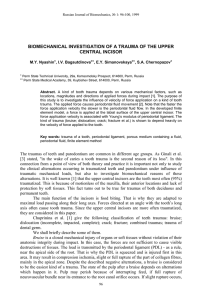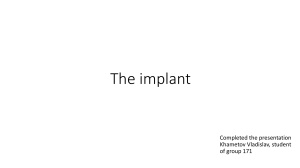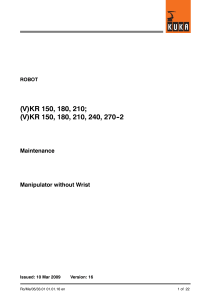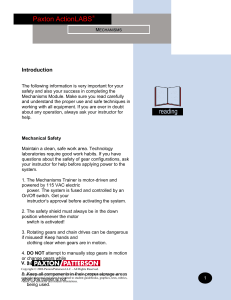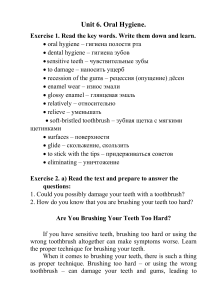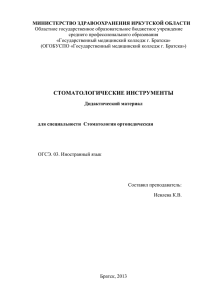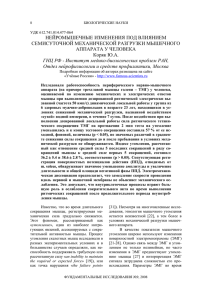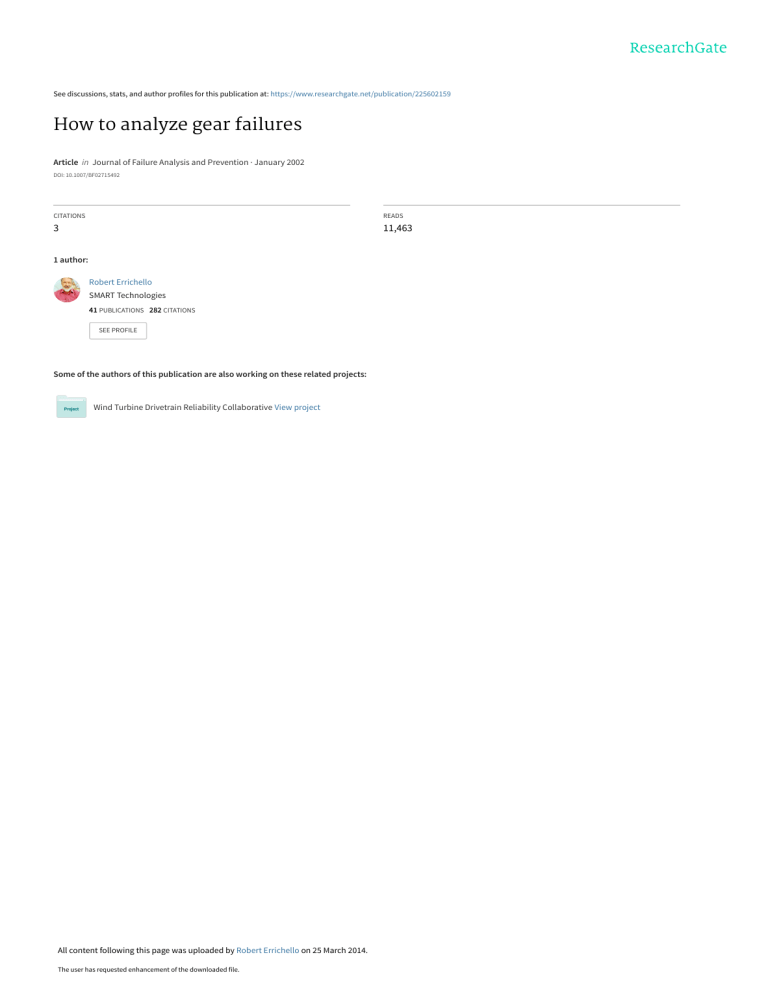
See discussions, stats, and author profiles for this publication at: https://www.researchgate.net/publication/225602159 How to analyze gear failures Article in Journal of Failure Analysis and Prevention · January 2002 DOI: 10.1007/BF02715492 CITATIONS READS 3 11,463 1 author: Robert Errichello SMART Technologies 41 PUBLICATIONS 282 CITATIONS SEE PROFILE Some of the authors of this publication are also working on these related projects: Wind Turbine Drivetrain Reliability Collaborative View project All content following this page was uploaded by Robert Errichello on 25 March 2014. The user has requested enhancement of the downloaded file. PRODUCT FOCUS: GEARING How to analyze gear failures ROBERT L. ERRICHELLO and JANE MULLER, Geartech By following a step-by-step procedure, engineers can diagnose gear failures and develop solutions. Here’s how to conduct a failure PTD--#11441 FIG 1 analysis, what to look for, and how to recognize common failures. W hen an important gear failure occurs, someone becomes responsible for analyzing the failure, determining its cause, and recommending a solution. A company can select its own engineer, an outside consultant, or both. If a consultant is called in, this should be done as early in the process as possible. Though similar procedures apply to any failure analysis, the specific approach can vary depending on when and where the inspection is made, the nature of the failure, and time constraints. When and where. Ideally, the engineer conducting the analysis should inspect the failed components as soon after failure as possible. If an early inspection is not possible, someone at the site must preserve the evidence based on instructions from the analyst. If a suitable facility for disassembling and inspecting the gearbox is not available on-site, it may be necessary to find an alternate location or bring the necessary equipment to the site. Nature of failure. The failure conditions can determine when and how to conduct an analysis. For example, if the gears are damaged but still able to function, the company may decide to continue their operation and monitor the Robert L. Errichello is president of Geartech, a gear research, analysis, and design consultant firm in Albany, Calif. Jane Muller is a consultant and gear failure analyst with the company. rate at which damage progresses. In this case, samples of the lubricant should be collected for analysis, the reservoir drained and flushed, and the lubricant replaced. If gearbox reliability is crucial to the application, the gears should be examined by magnetic particle inspection to ensure that they have no cracks. The monitoring phase will consist of periodically checking the gears for damage by visual inspection and by measuring sound and vibration. Time constraints. In some situations, the high cost of shutting down equipment limits the time available for inspection. Such cases call for careful planning. For example, dividing tasks between two or more analysts reduces the time required. Preparing for inspection Before visiting the failure site, interview a contact person located at the site and explain what you need to inspect the gearbox including personnel, equipment, and working conditions. 18.5--56Y (a) (b) Figure 1 — Typical gear tooth contact patterns: (a), aligned, and (b), misaligned. Figure 2 — Bending 18.5C--27.5K fatigue fracture surfaces of gear teeth. Upper 56C--11.5M--43K tooth has multiple origins 20Y--20K of failure. 50Y--50K POWER TRANSMISSION DESIGN ■ MARCH 1994 35 PRODUCT FOCUS: GEARING Request a skilled technician to disassemble the equipment under your direction. But, make sure that no work is done on the gearbox until you arrive. This means no disassembly or cleaning. Otherwise, a wellmeaning technician could inadvertently destroy evidence. Verify that the gearbox drawings, disassembly tools, and adequate inspection facilities are available. Ask for as much background information as possible, including manufacturer’s part numbers, gear and bearing runtime (hr), service history, and lubricant type. Now, it’s time to assemble your inspection equipment, including items such as a magnifying glass, measuring tools, felt tip markers, lubricant sampling equipment, and photographic equipment. A well-designed set of inspection forms for the gearbox, gears, and bearings should be at the top of your priority list. Failure inspection Before starting the inspection, review the background information and service history with the contact person. Then interview those involved in the design, installation, operation, maintenance, and failure of the gearbox. Encourage them to tell everything they know about the gearbox even if they feel it is not important. After completing the interviews, explain your objectives to the technician who will be working with you. Review the gearbox assembly drawings with the technician, checking for potential disassembly problems. Visual examination. Before disassembling the gearbox, thoroughly inspect its exterior. Use an inspection form as a guide to ensure that you record important data that would other- Figure 3 — Fatigue crack in a gear tooth root fillet. wise be lost once disassembly begins. For example, the condition of seals and keyways must be recorded before disassembly. Otherwise, it will be impossible to determine when any damage may have occurred to these parts. Gear tooth contact patterns should be taken before completely disassembling the gearbox (see next section). After the external examination, disassemble the gearbox and inspect all internal components, both failed and undam- Figure 4 — Fatigue failure (pitting) in the contact surface of a gear tooth. Beach marks are visible in some of the larger pits. 36 POWER TRANSMISSION DESIGN ■ MARCH 1994 aged. Examine closely the functional surfaces of gear teeth and bearings and record their condition. Before cleaning the parts, look for signs of corrosion, contamination, and overheating. After the initial inspection, wash the components with solvents and re-examine them. This examination should be as thorough as possible because it is often the most important phase of the investigation and may yield valuable clues. A low power magnifying glass and pocket microscope are helpful tools for this examination. It is important to inspect the bearings because they often provide clues as to the cause of gear failure. For example: • Bearing wear can cause excessive radial clearance or end play that misaligns the gears. • Bearing damage may indicate corrosion, contamination, electrical discharge, or lack of lubrication. • Plastic deformation between rollers and raceways may indicate overloads. • Gear failure often follows bearing failure. Gear tooth contact patterns. (Complete this step before disassembling gearbox components for inspection). The way in which mating gear teeth contact indicates how well they are aligned, Figure 1. If practical, record tooth contact patterns under either loaded or unloaded conditions. For no-load tests, paint the teeth of one gear with marking compound. Then, roll the teeth through mesh so the compound transfers the contact pattern to the unpainted gear. Lift the pattern from the gear with scotch tape and mount it on paper to form a permanent record. For loaded tests, paint several teeth on Table 1 — Gear tooth failure nomenclature Class General mode Bending fatigue Low-cycle fatigue Specific mode High-cycle fatigue Root fillet cracks one or both gears with maan effective lubricant analysis Profile cracks chinist’s layout lacquer. Run depends on how well the samTooth end cracks the gears under load for a sufple represents the operating ficient time to wear off the Contact fatigue Macropitting Nonprogressive lubricant. To take samples lacquer and establish the Progressive from a gearbox drain valve, contact patterns. Photograph Spall first discard stagnant oil from the patterns to obtain a perFlake the valve. Then take a sample manent record. Micropitting at the start, middle, and end of Document observations. Subcase fatigue a drain to avoid stratification. Describe all important obserTo sample from the reservoir, vations in writing, using Wear Adhesion Mild draw samples from the top, sketches and photographs Moderate middle, and near the bottom. where needed. Identify and Abrasion Mild Examine the oil filter and magmark each component (inModerate netic plug for wear debris and cluding gear teeth and bearSevere contaminants. ing rollers), so it is clearly Corrosion Samples from the oil storage identified in the written deFretting corrosion drum or reservoir can uncover scription, sketches, and phoPolishing Mild problems such as excessive watographs. It is especially imModerate ter in the oil due to improper portant to mark all bearings, Severe storage. including inboard and outElectric discharge Have you got it all? Before board sides, so their location Cavitation leaving the site, make sure and position in the gearbox Erosion that you have everything can be determined later. needed — completed inspecScuffing Scuffing Mild Describe components in a tion forms, written descripModerate consistent way. For example, tions and sketches, photos, Severe always start with the same and test specimens — for compart of a bearing and progress pleting the failure analysis. Overload Brittle fracture through the parts in the same Ductile fracture sequence. This helps to avoid Determine Mixed-mode fracture overlooking any evidence. type of failure Plastic deformation Cold flow Concentrate on collecting Hot flow evidence, not on determining Indentation Now it’s time to examine all the cause of failure. RegardRolling of the information and deterless of how obvious the cause Rippling mine how the gear (or gears) may appear, do not form conRidging failed. clusions until all the evidence Root fillet yielding Several failure modes may is considered. Tip-root interference be present and you need to Gear geometry. The load identify which is the primary capacity of the gearset will Cracking Hardening cracks mode, and which are secneed to be calculated later. Grinding cracks ondary modes that may have For this purpose, obtain the Rim and web cracks contributed to failure. Table 1 following geometry data, eiCase-core separation lists six general classes of gear ther from the gears and gear failure modes, of which the housing or their drawings: first four are the most com• Number of teeth. ing the inspection, you will begin to for- mon. An understanding of these four • Outside diameter. mulate hypotheses regarding the cause of common modes will enable you to iden• Face width. • Gear housing center distance for failure. With these hypotheses in mind, tify the cause of failure. each gearset. select specimens for laboratory testing. 1. Bending fatigue. This common type Take broken parts for laboratory evalua- of failure is a slow, progressive failure • Whole depth of teeth. • Tooth thickness (both span and top tion or, if this is not possible, ensure that caused by repeated loading. It occurs in land measurement). they will be preserved for later analysis. three stages: Specimens for laboratory tests. DurOil samples can be very helpful. But, • Crack initiation. Plastic deformation POWER TRANSMISSION DESIGN ■ MARCH 1994 37 PRODUCT FOCUS: GEARING occurs in areas of stress concentration or discontinuities, such as notches or inclusions, leading to microscopic cracks. • Crack propagation. A smooth crack grows perpendicular to the maximum tensile stress. • Fracture. When the crack grows large enough, it causes sudden fracture. As a fatigue crack propagates, it leaves a series of “beach marks” — visible to the naked eye — that correspond to positions where the crack stopped, Figure 2. The origin of the crack is usually surrounded by several concentric curved beach marks. Most gear tooth fatigue failures occur in the tooth root fillet, Figure 3, where cyclic stress is less than the yield strength of the material and the number of cycles is more than 10,000. This condition is called high-cycle fatigue. A large part of the fatigue life is spent initiating cracks, whereas a shorter time is required for the cracks to propagate. Stress concentrations in the fillet often cause multiple crack origins, each producing separate cracks. In such cases, cracks propagate on different planes and may join to form a step, called a ratchet mark, Figure 2. 2. Contact fatigue. In another failure mode, called contact or Hertzian fatigue, repeated stresses cause surface cracks and detachment of metal fragments from the tooth contact surface, Figure 4. The most common types of surface fatigue are macropitting (visible to the naked eye) and micropitting. Macropitting occurs when fatigue cracks start either at or below the surface. As the cracks grow, they cause a piece of surface material to break out, forming a pit with sharp edges. Based on the type of damage, macropitting is categorized as nonprogressive, progressive, spall, or flake. The nonprogressive type consists of pits less than 1 mm diam in localized areas. These pits distribute load more evenly by removing high points on the surface, after which pitting stops. Progressive macropitting consists of pits larger than 1 mm diam that cover a significant portion of the tooth surface. Figure 5 — Adhesion type wear of gear teeth. In one type, called spalling, the pits coalesce and form irregular craters over a large area. In flake macropitting, thin flakes of material break out and form triangular pits that are relatively shallow, but large in area. Micropitting has a frosted, matte, or gray stained appearance. Under magnification, the surface is shown to be covered by very fine pits (less than 20 mm deep). Metallurgical sections through these pits show fatigue cracks that may extend deeper than the pits. 3. Wear. Gear tooth surface wear involves removal or displacement of material due to mechanical, chemical, or electrical action. The three major types of wear are adhesion, abrasion, and polishing. Adhesion is the transfer of material from the surface of one tooth to that of another due to welding and tearing, Figure 5. It is confined to oxide layers on the tooth surface. Adhesion is categorized as mild or moderate, whereas severe adhesion is termed scuffing (described later). Typically, mild adhesion occurs during gearset run-in and subsides after it wears local imperfections from the surface. To the unaided eye, the surface appears undamaged and machining marks are still visible. Moderate adhesion removes some or all of the machining marks from the contact surface. Under certain conditions, it can lead to excessive wear. Abrasion is caused by contaminants in the lubricant such as sand, scale, rust, machining chips, grinding dust, weld splatter, and wear debris. It appears as smooth, parallel scratches or gouges, Figure 6. Abrasion ranges from mild to severe. Mild abrasion consists of fine scratches that don't remove a significant amount of material from the tooth contact surface, whereas moderate abrasion removes most of the machining marks. Severe abrasion, which removes all machining marks, can cause wear steps at the ends of the contact surface and in the dedendum. Tooth thickness may be reduced significantly, and in some cases, the tooth tip is Figure 6 — Excessive abrasion type wear. Photo: ANSI/AGMA Standard 110.04 38 POWER TRANSMISSION DESIGN ■ MARCH 1994 Figure 7 — Polishing type wear. reduced to a sharp edge. Finally, polishing is fine-scale abrasion that imparts a mirror-like finish to gear teeth, Figure 7. Magnification shows the surface to be covered by fine scratches in the direction of sliding. Polishing is promoted by chemically active lubricants that are contaminated with a fine abrasive. Polishing ranges from mild to severe. Its mild form, which is confined to high points on the surface, typically occurs during run-in and ceases before machining marks are removed. Moderate polishing removes most of the machining marks. Severe polishing removes all machining marks from the tooth contact surface. The surface may be wavy or it may have wear steps at the ends of the contact area and in the dedendum. 4. Scuffing. Severe adhesion or scuffing transfers metal from the surface of one tooth to that of another, Figure 8. Typically, it occurs in the addendum or dedendum in bands along the direction of sliding, though load concentrations can cause localized scuffing. Surfaces have a rough or matte texture that, under magnification, appear to be torn and plastically deformed. Scuffing ranges from mild to severe. Mild scuffing occurs on small areas of a tooth and is confined to surface peaks. Generally, it is nonprogressive. Moderate scuffing occurs in patches that cover significant portions of the teeth. If operating conditions do not change, it can be progressive. Severe scuffing occurs on significant portions of a gear tooth (for example, the entire addendum or dedendum). In some cases, surface material is plastically deformed and displaced over the tooth tip or into the tooth root. Unless corrected, it is usually progressive. Tests and calculations aid analysis In many cases, failed parts and inspection data don’t yield enough information to determine the cause of failure. When this happens, gear design calculations and laboratory tests are usually needed to develop and confirm a hypothesis for the probable cause. Gear design calculations. The gear geometry data collected earlier aids in estimating tooth contact stress, bending stress, lubricant film thickness, and gear tooth contact temperature based on transmitted loads for each gear. These values are calculated according to American Gear Manufacturers Association standards such as ANSI/AGMA 2001-B88 for spur and helical gears. Comparing these calculated values with AGMA allowable values helps to determine the risk of macropitting, bending fatigue, and scuffing. Laboratory examination and tests. A microscopic examination may confirm the failure mode or find the origin of a fatigue crack. Both light microscopes and scanning electron microscopes (SEM) are useful for this purpose. An SEM with an energy dispersive X-ray is especially useful for identifying corrosion, contamination, or inclusions. If the primary failure mode is likely to be influenced by gear geometry, check for any geometric or metallurgical defects that may have contributed to the failure. For example, if tooth contact patterns indicate misalignment or interference, inspect the gear for accuracy on gear inspection machines. Conversely, where contact patterns indicate good alignment and the calculated loads are within rated gear capacity, check the teeth for metallurgical defects. Conduct nondestructive tests before any destructive tests. These nondestructive tests, which aid in detecting material or manufacturing defects and provide rating information, include: • Surface hardness and roughness. • Magnetic particle inspection. • Acid etch inspection. • Gear tooth accuracy inspection. Then conduct destructive tests to evaluate material and heat treatment. These tests include: • Microhardness survey. • Microstructural determination using various acid etches. • Determi- Figure 8 — Scuffing of gear tooth surfaces. POWER TRANSMISSION DESIGN ■ MARCH 1994 39 PRODUCT FOCUS: GEARING nation of grain size. • Determination of nonmetallic inclusions. • SEM microscopy to study fracture surfaces. Form and test conclusions bricant. Results of this evaluation may make it necessary to modify or abandon the initial hypotheses. Or, pursue new lines of investigation. Finally, after thoroughly testing the hypotheses against the evidence, you reach a conclusion about the most probable cause of failure. In addition, you may identify secondary factors that contributed to the failure. cinctly, preferably in tables or figures. Good photos are especially helpful for portraying failure characteristics. The report usually contains recommendations for repairing the equipment, or making changes in equipment design or operation to prevent future failures. ■ Reporting results A failure analysis report should describe all relevant facts found during the analysis, the inspections and tests, weighing of evidence, conclusions, and recommendations. Present the data suc- View publication stats When all calculations and tests are completed, you need to form one or more hypotheses for the probable cause of failure, then determine if the evidence supports or disproves the hypotheses. Here, you need to evaluate all of the evidence that was gathered including: • Documentary evidence and service history. • Statements from witnesses. • Written descriptions, sketches, and photos. • Gear geometry and contact patterns. • Gear design calculations. • Laboratory data for materials and lu- 40 POWER TRANSMISSION DESIGN ■ MARCH 1994


